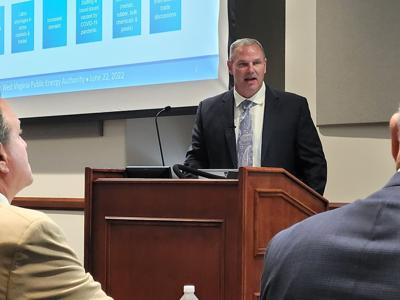CHARLESTON �����Ƶ� Appalachian Power has asked West Virginia officials to consider a tool that proponents have touted as an effective way to finance retiring coal-fired assets.
Company President and CEO Chris Beam pitched the tool known as securitization to West Virginia Public Energy Authority members at their latest meeting.
Securitization is designed to lower electricity rates by replacing a utility�����Ƶ�s rate of return on its investment capital with low-interest bonds paid back over a long period, reducing utility debt. The process may stretch out cost recovery over a longer period of time, resulting in lower rates.
�����Ƶ�(H)opefully it would mean two things,�����Ƶ� Beam told the Public Energy Authority at its meeting last month. �����Ƶ�One, hopefully, if the math works out, you would lower customers�����Ƶ� bills, which would be great. Two, these assets at the end of the day become cheaper to operate.�����Ƶ�
Beam said securitization �����Ƶ�gives finality�����Ƶ� on coal-fired assets.
�����Ƶ�I know that�����Ƶ�s always an argument that comes up �����Ƶ� how long are they going to be around, 2030, 2040, 2050?�����Ƶ� Beam said. �����Ƶ�This brings finality to all that, some closure to all that. So it�����Ƶ�s something we�����Ƶ�re looking at.�����Ƶ�
Beam said Appalachian Power indicated it would need state legislation to allow it to securitize its coal-fired assets.
State approval can allow utilities to receive bonds with a high enough rating to provide savings for ratepayers.
Appalachian Power previously received state approval to use securitization to lessen ratepayer impacts from a company under-recovery of fuel costs. But the company has never gotten securitization approval for assets, Beam said.
�����Ƶ�If we can get the math to work out where it can help to lower the customers�����Ƶ� bills, then our plans will be to come up with an education campaign and start coming around to the legislators and try to educate them on what we�����Ƶ�re thinking about,�����Ƶ� Beam said.
In 2012, the West Virginia Legislature authorized the state Public Service Commission to issue a financing order to allow the recovery of fuel costs through rate relief bonds financed at a lower cost to customers than usual utility financing.
Appalachian Power spokesman Phil Moye recalled that a company under-recovery of fuel costs that began in 2008 had grown to $350 million by 2013, something the company attributed to a recession depressing electricity sales and steadily rising coal prices.
Recovery through the portion of bills for fuel costs �����Ƶ� called the Expanded Net Energy Cost �����Ƶ� would have required a 30% rate increase, Moye said.
Instead, securitization spread the recovery of fuel costs over 15 years.
John Scalzo, regulatory and finance vice president at Appalachian Power, argued against further fuel securitization in an evidentiary hearing in a fuel cost case earlier this year, contending that traditional cost recovery would be a better option than securitization.
�����Ƶ�We�����Ƶ�ve done it once,�����Ƶ� Scalzo said of securitization. �����Ƶ�We�����Ƶ�re still paying for it. You�����Ƶ�d be layering a second one on.�����Ƶ�
Earlier this month, the Public Service Commission affirmed an order it issued in October approving environmental upgrades allowing three power plants in West Virginia controlled by American Electric Power, Appalachian Power�����Ƶ�s parent company, to keep operating through 2040.
The commission�����Ƶ�s order approved West Virginia ratepayers picking up a burden of nearly $22 million per year from Virginia and Kentucky customers to pay for wastewater treatment upgrades at the John Amos, Mountaineer and Mitchell plants in Putnam, Mason and Marshall counties, respectively.
Kentucky and Virginia utility regulators, which share jurisdiction of the plants, blocked the companies�����Ƶ� requests to stay compliant with federal wastewater rules on the grounds that their plans were uneconomic.
Securitization advocates say the process allows utilities to direct investments toward renewable resources and provides savings that can be used to help workers and communities affected by plant closures.
In a 2018 report, the Sierra Club, an environmental nonprofit, and Rocky Mountain Institute, a clean energy research nonprofit, estimated that every $100 million in coal plants retired through securitization can unlock around $60 million in avoided capital costs that can assist communities facing an energy and economic transition.
Colorado, Montana and New Mexico were three of the first states to permit securitization of costs associated with early coal retirements in 2019, according to the National Conference of State Legislatures. More states have approved measures to keep ratepayers from being on the hook for stranded assets in the form of uneconomic coal plants since then.
Chris Hansen, a Democratic Colorado state senator, touted his state�����Ƶ�s 2019 law in an August 2021 webinar sponsored by the West Virginia Center on Climate Change, the West Virginia College of Law Center of Energy and Sustainable Development, and the West Virginia Climate Alliance.
Hansen suggested using ratepayer-backed bonds to pay off stranded coal assets, saying they are cheaper than using utility financing due to lower interest rates and generate ratepayer savings that can then be used to lower power costs, pay for new generation assets and reduce rates or retrain workers displaced by coal plant and mine retirements.
�����Ƶ�Of course, it�����Ƶ�s a much easier political conversation when you talk about how do we share the savings pie as opposed to who gets charged more for an energy policy change,�����Ƶ� Hansen said. �����Ƶ�And I think that�����Ƶ�s one of the things that really makes this nonpartisan. This is just a spreadsheet exercise.�����Ƶ�













